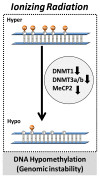Epigenetics meets radiation biology as a new approach in cancer treatment
- PMID: 23873297
- PMCID: PMC3742287
- DOI: 10.3390/ijms140715059
Epigenetics meets radiation biology as a new approach in cancer treatment
Abstract
Cancer is a disease that results from both genetic and epigenetic changes. In recent decades, a number of people have investigated the disparities in gene expression resulting from variable DNA methylation alteration and chromatin structure modification in response to the environment. Especially, colon cancer is a great model system for investigating the epigenetic mechanism for aberrant gene expression alteration. Ionizing radiation (IR) could affect a variety of processes within exposed cells and, in particular, cause changes in gene expression, disruption of cell cycle arrest, and apoptotic cell death. Even though there is growing evidence on the importance of epigenetics and biological processes induced by radiation exposure in various cancer types including colon cancer, specific epigenetic alterations induced by radiation at the molecular level are incompletely defined. This review focuses on discussing possible IR-mediated changes of DNA methylation and histone modification in cancer.
Figures


References
-
- Little J.B. Induction of genetic instability by ionizing radiation. C. R. Acad. Sci. III. 1999;322:127–134. - PubMed
-
- Little J.B. Radiation carcinogenesis. Carcinogenesis. 2000;21:397–404. - PubMed
-
- Jones P.A., Baylin S.B. The fundamental role of epigenetic events in cancer. Nat. Rev. Genet. 2002;3:415–428. - PubMed
Publication types
MeSH terms
Substances
LinkOut - more resources
Full Text Sources
Other Literature Sources

